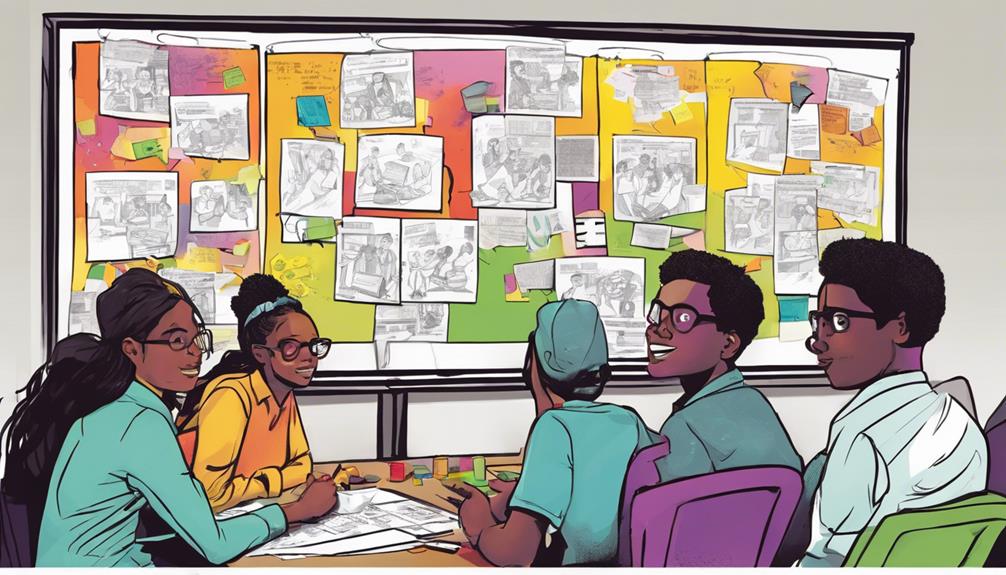Using powerful body language jazzes up teaching and makes students more lively. Gestures, facial expressions, and posture shape how students connect with you. Keeping open body language makes things cozy. Sprinkle in gestures to highlight key points and show excitement. Stand tall, make eye contact, and move with confidence to show you’re in charge. Use lively body signals to get students more involved. Eyes locked in, hands moving, and different voice tones all spice up the learning vibe. **Body language** can really pump up teaching and make the classroom buzz.
Key Takeaways
- Use dynamic body language cues to enhance student participation and engagement.
- Maintain eye contact to build rapport and show attentiveness.
- Employ hand gestures to emphasize key points and sustain interest.
- Move around the classroom to command attention and focus.
- Vary tone of voice to convey enthusiasm and encourage student participation.
Importance of Non-Verbal Communication
Enhancing your teaching through powerful body language begins with recognizing the critical importance of non-verbal communication in the classroom. Your gestures, facial expressions, and posture convey messages that impact student engagement and classroom dynamics.
When you maintain open body language, such as facing students and making eye contact, you create a welcoming environment for learning. By using gestures to emphasize key points or show enthusiasm, you can capture students' attention and enhance their understanding.
Influence on Classroom Dynamics

By utilizing powerful body language, you can greatly impact classroom dynamics and student engagement. Your body language sets the tone for the class, influencing how students interact and participate.
When you maintain strong posture and make eye contact, students are more likely to pay attention and respect your authority. Gestures and movements can convey enthusiasm, encouraging students to engage actively with the lesson. A confident stance can help you establish control over the class, reducing disruptions and creating a positive learning environment.
Being aware of your body language can also help you gauge student reactions and adjust your teaching approach accordingly. Overall, your body language plays a significant role in shaping classroom dynamics and fostering student involvement.
Enhancing Student Participation

To enhance student participation in the classroom, consciously incorporate dynamic body language cues into your teaching style. Your movements and gestures can greatly impact student engagement.
Maintain eye contact to show attentiveness and build rapport. Use hand gestures to emphasize key points and maintain student interest. Move around the classroom to command attention and keep students focused.
Vary your tone of voice to convey enthusiasm and encourage active participation. Smile genuinely to create a welcoming atmosphere and show approachability. Avoid crossing your arms, as it may indicate defensiveness or disinterest.
Confidence Building for Educators

Incorporate effective body language practices to boost your confidence and elevate your teaching presence in the classroom.
As an educator, displaying confident body language can positively impact your teaching effectiveness.
Maintaining good posture, making eye contact, and using expressive gestures can convey authority and assurance to your students.
When you exude confidence through your body language, you create a more engaging and dynamic learning environment.
Adjusting your body language to appear more confident can also help improve your emotional state and interactions with students.
Remember that your non-verbal cues play a significant role in how you're perceived as a teacher.
Impact on Teaching Effectiveness

Improving your body language skills can greatly impact your teaching effectiveness in the classroom. Your body language influences student engagement, behavior, and overall learning outcomes.
- Engagement: Energetic and animated body language boosts students' energy levels and positively affects engagement, making lessons more captivating.
- Behavior: Clear and supportive body language helps manage the classroom environment, reducing disruptions, and fostering a positive learning atmosphere.
- Learning Outcomes: Utilizing influential body language enhances student comprehension, motivation, and participation, leading to improved academic performance.
Frequently Asked Questions
How Can Teachers Use Body Language to De-Escalate Conflicts in the Classroom?
To de-escalate conflicts in the classroom, maintain calm body language, use open gestures, and make eye contact. Show empathy through facial expressions and maintain a composed posture. Non-verbal cues can defuse tensions and promote a positive resolution.
What Are Some Strategies for Incorporating Cultural Sensitivity Into Body Language Cues?
To incorporate cultural sensitivity into body language cues, try adapting gestures and expressions to respect diverse backgrounds. Use exaggerated gestures and facial expressions to engage students, creating a welcoming environment that appreciates different cultural norms.
How Does Body Language Vary in Virtual Teaching Compared to In-Person Instruction?
In virtual teaching, your body language adapts to the screen, maintaining eye contact, using expressive gestures, and displaying engaging facial expressions. Adjusting your energy levels and posture effectively conveys enthusiasm and helps maintain student engagement.
Can Body Language Be Used to Support Students With Special Needs or Disabilities Effectively?
You can use body language effectively to support students with special needs or disabilities. Non-verbal cues like gestures and facial expressions can aid in communication, foster understanding, and create a positive learning environment, enhancing student engagement and comprehension.
Are There Specific Body Language Techniques to Encourage Peer Interaction Among Students?
To encourage peer interaction among students, maintain open body language, encourage eye contact, and use positive gestures like nods and smiles. Engage students through active listening and group activities, fostering a collaborative learning environment.
Conclusion
To sum up, honing the art of powerful body language can greatly enhance your teaching skills and classroom dynamics. By recognizing the significance of non-verbal communication, educators can create a more engaging and positive learning environment.
So, why not take the time to refine your body language and see the transformative impact it can have on your teaching practice? Your students will thank you for it.











